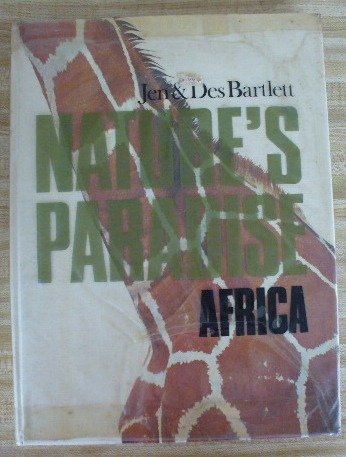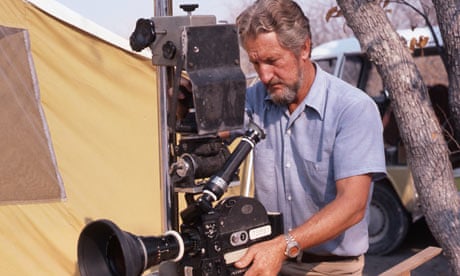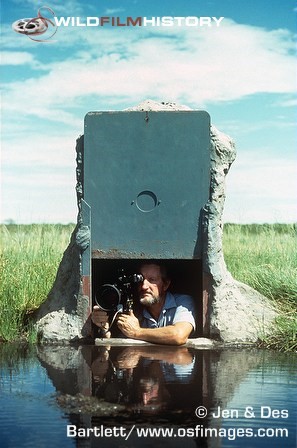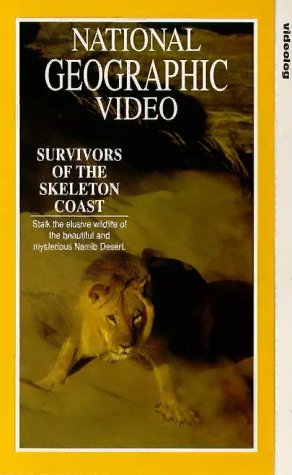Des & Jen Bartlett - film-makers
Pioneering work in television documentaries.
Des & Jen Bartlett
Des & Jen Bartlett became one of the world's leading wildlife film makers in a career that lasted more than 50 years.
In 1956, Bartlett was married in London to a fellow Australian, Jen Edmondson, who was playing tennis at Wimbledon. So began one of the most successful and enduring husband-and-wife partnerships in wildlife film history, with him shooting the moving pictures and her most of the stills. She gave up her tennis career to return with him to Africa, where Armand was producing documentaries for the BBC. The first series, Filming in Africa (1955), was followed by On Safari(1957-59 and 1961-65). Presented by Armand and his wife, Michaela, the programs' animal behaviour sequences were largely the work of Bartlett and helped establish the popularity of the television wildlife documentary.
They finally married in England when Jen, a former tennis player who competed with Rod Laver, Ken Rosewall and Althea Gibson, was on a tennis trip and Des was scheduled to return to Africa to film. Since then, their home has been wherever they worked, from Alaska to Suriname and Argentina to Africa (they've made 14 films in Etosha National Park). Des Bartlett began making wildlife films in 1952. Unlike most wildlife photographers in the days of black-and-white television, he has always shot in color. He made 14 films in Etosha National Park, and said that the fate of the animals is "one of the conservation messages we try to get across."Des Bartlett
Norman Desmond Bartlett was born on April 2, 1927 in Canungra, Queensland. His father was a head teacher and keen naturalist who had the largest private butterfly collection in Australia and imbued his son with an early interest in natural history. Bartlett started work in a Brisbane bank at 16 but had ambitions to be a pilot and aircraft designer. He joined the ATC (Air Training Corps) and his design of the Bartlett Bullet plane was published in a 1944 edition of Wings magazine, the official journal of the RAAF. After turning 18, Bartlett joined the RAAF, but his dreams of becoming a fighter pilot were never fulfilled as the war came to an end. He turned instead to photography, running a studio in Brisbane with a friend before taking a job at the department of information's films division in Melbourne.
He began his career in 1952 spending 12 months filming in eastern and central Australia for Under the Southern Cross, a documentary by Armand. Bartlett spent five months on his own travelling by dugout canoe to a remote area of New Guinea to film the Sepik River people for the Denises' feature film, Among the Headhunters. In 1954 he flew to Kenya to join the Denises, who had signed a contract with the BBC. The resulting television programs, Filming in Africa and On Safari, became extremely popular. Bartlett was based in Kenya for 10 years, filming 70 half-hour programs and 104 short Animalandchildren's films. After the birth of their daughter Julie, in Australia in 1957, the Bartletts returned to Kenya. Julie lived an idyllic childhood ''on safari'' and Des realised a boyhood dream when he and Jen learned to fly. In 1964, he went to film in North America. Eighteen months later Armand retired and Bartlett signed with Britain's Survival Anglia, whose wildlife shows were sold to more than 100 countries. Patient, painstaking, reliable and modest yet resourceful, Bartlett remained one of Survival's top three cameramen for 20 years. His film World of the Beaver (1970) helped to establish the one-hour wildlife documentary as a component of the peak-time television schedules, and in 1973 won an Emmy for Flight of the Snow Geese. The Bartletts followed the geese on their 4000-kilometre migration from Hudson Bay to the Mississippi Delta, obtaining stunning footage of the birds in flight by adopting orphans that regarded them as parents and could be filmed in close-up. In 1978 they went back to Africa, planning to spend six months filming lions in Namibia, but stayed for over 30 years.Courtesy: wildfilmhistory.org/
AFRICA - Natures Paradise
Besides making award-winnjing films and documentaries, the Bartlett team also published a notable book on Africa - here is a book overview:
In recent years many admirable books have been inspired by the wildlife and scenery of Africa, but here is one that stands supreme. As a photographic study of a spectacular continent it is unsurpassed. As a brilliant exposition of the way in which the mammals, birds, insects, fish and reptiles of Africa are dependent on their habitat and on each other it is fascinating and unique. Des Bartlett has unrivalled skills and experience as a photographer of wildlife and is an excellent field naturalist. Records for posterity the natural treasures of one of the areas of the world where wildlife is still truly wild-a record of treasures as precious and important as the gothic cathedrals, paintings and sculptures of Europe. This volume has seven sections devoted to different types of habitat-the coral reef, the dry thornbush country, open bush and woodland, the plains, the lakes, the forests, and the mountains near the equator. In an eighth section the author illustrates the varying consequences, some of them disastrous, that follow natural and human interferences with the habitat upon which the animals precariously depend for their existence. Every chapter is introduced by a four-page commentary, and full captions accompany the photographs. With its lavish production this magnificent book, which is to be followed by others on Africa, America and Australis, is one that will appeal to the widest general public as well as to anyone who has a special or specialist interest in natural history, photography or the African continent.
Courtesy: wildfilmhistory.org/



